HLSC122 Assessment 3: Drug Testing in Music Festivals and Teenagers
VerifiedAdded on 2022/11/25
|8
|1947
|408
Report
AI Summary
This report critically appraises a research paper by Day et al. (2018) which investigates illicit drug use among young people attending music festivals and their attitudes toward drug checking services. The report is divided into two parts: Part A provides a critical appraisal of the research paper, evaluating its authorship, research question, design, methods, results, and limitations. It highlights the study's strengths, such as its focus on a relevant and timely topic, while also acknowledging limitations like the sample's lack of generalizability. Part B applies the evidence to practice by discussing the enablers and barriers to implementing the research findings, particularly addressing concerns about drug testing potentially promoting drug use. The report concludes by emphasizing the importance of disseminating information about drug-related harms to bring about behavioral changes, underscoring the potential of drug checking services as a harm reduction strategy.
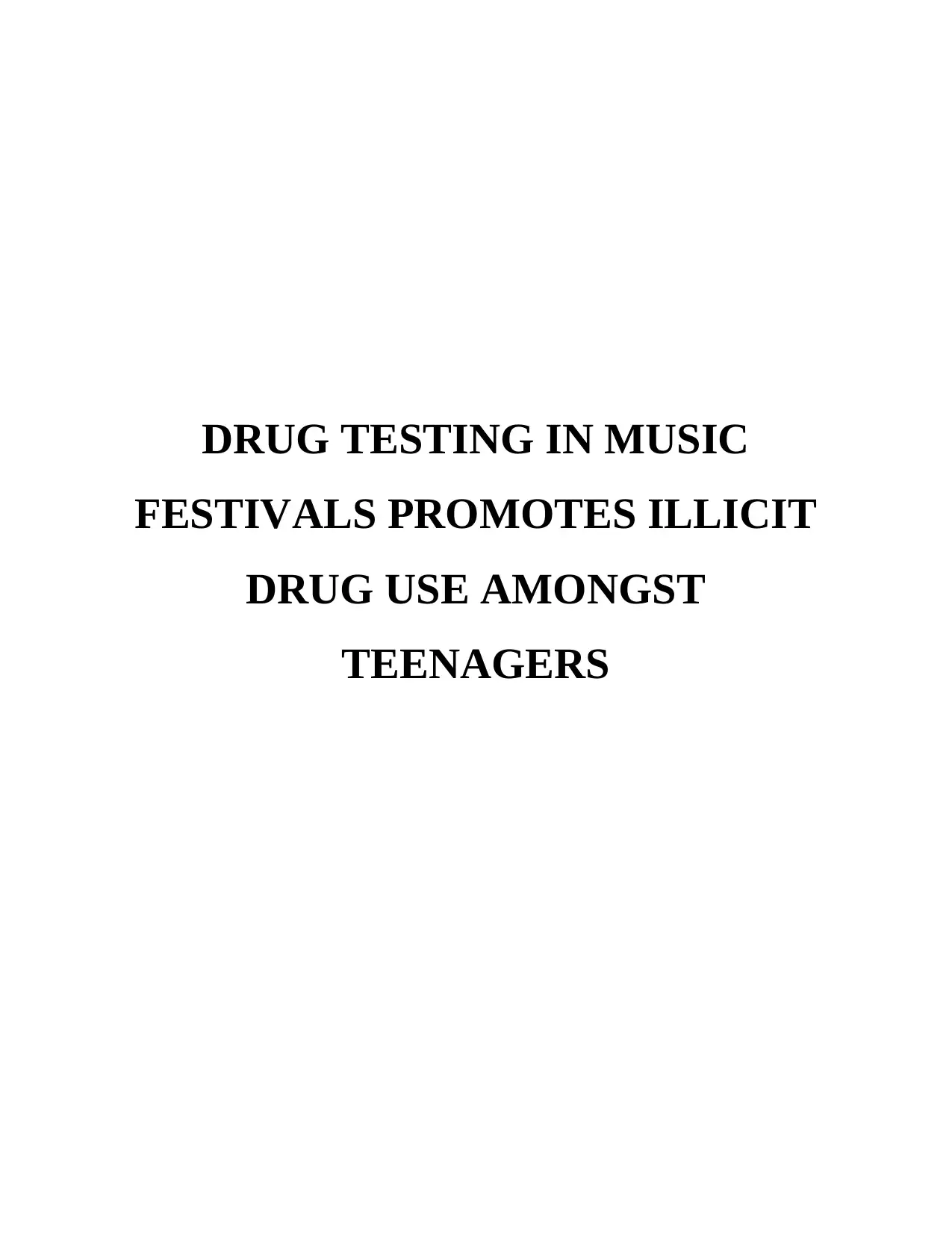
DRUG TESTING IN MUSIC
FESTIVALS PROMOTES ILLICIT
DRUG USE AMONGST
TEENAGERS
FESTIVALS PROMOTES ILLICIT
DRUG USE AMONGST
TEENAGERS
Paraphrase This Document
Need a fresh take? Get an instant paraphrase of this document with our AI Paraphraser
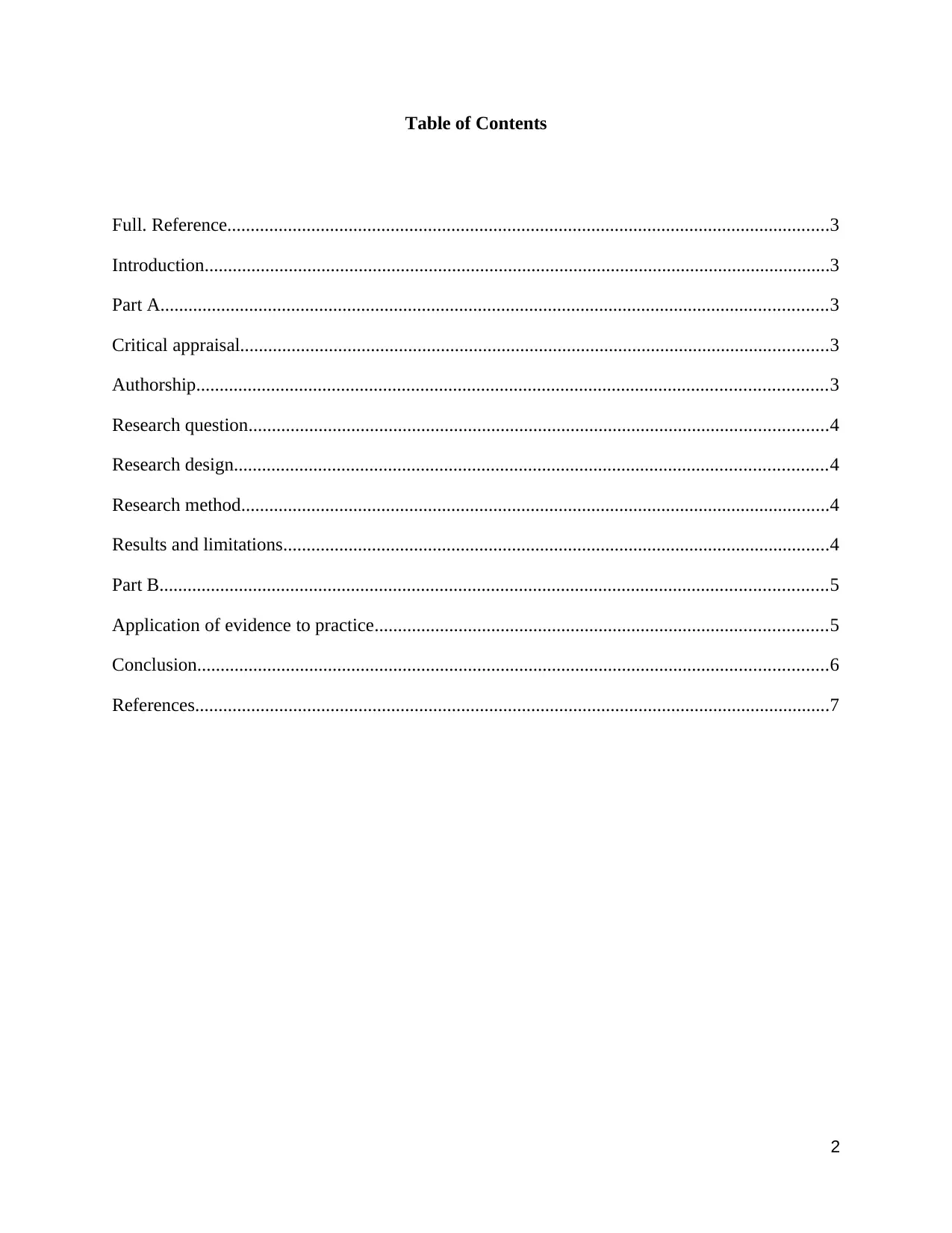
Table of Contents
Full. Reference.................................................................................................................................3
Introduction......................................................................................................................................3
Part A...............................................................................................................................................3
Critical appraisal..............................................................................................................................3
Authorship.......................................................................................................................................3
Research question............................................................................................................................4
Research design...............................................................................................................................4
Research method..............................................................................................................................4
Results and limitations.....................................................................................................................4
Part B...............................................................................................................................................5
Application of evidence to practice.................................................................................................5
Conclusion.......................................................................................................................................6
References........................................................................................................................................7
2
Full. Reference.................................................................................................................................3
Introduction......................................................................................................................................3
Part A...............................................................................................................................................3
Critical appraisal..............................................................................................................................3
Authorship.......................................................................................................................................3
Research question............................................................................................................................4
Research design...............................................................................................................................4
Research method..............................................................................................................................4
Results and limitations.....................................................................................................................4
Part B...............................................................................................................................................5
Application of evidence to practice.................................................................................................5
Conclusion.......................................................................................................................................6
References........................................................................................................................................7
2
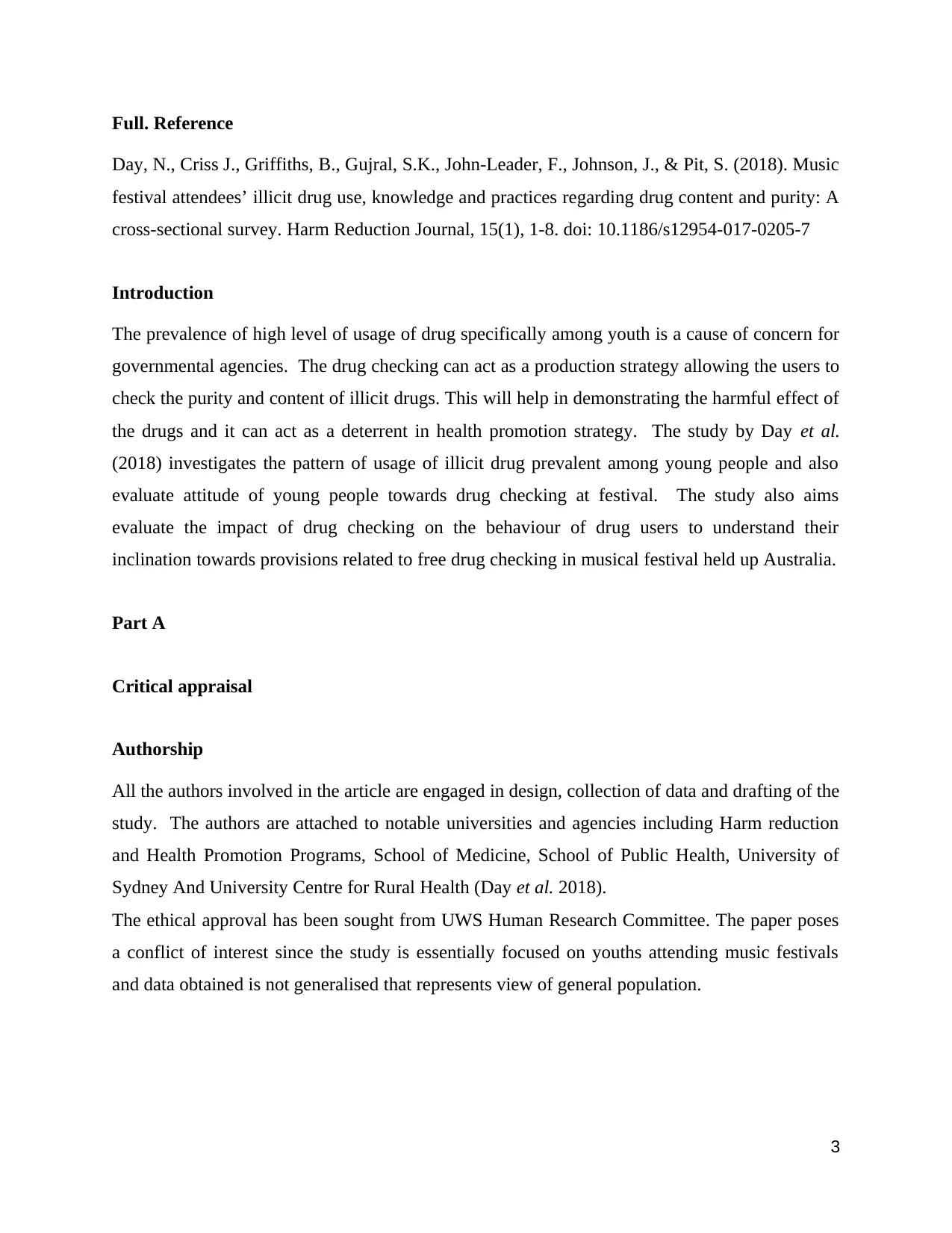
Full. Reference
Day, N., Criss J., Griffiths, B., Gujral, S.K., John-Leader, F., Johnson, J., & Pit, S. (2018). Music
festival attendees’ illicit drug use, knowledge and practices regarding drug content and purity: A
cross-sectional survey. Harm Reduction Journal, 15(1), 1-8. doi: 10.1186/s12954-017-0205-7
Introduction
The prevalence of high level of usage of drug specifically among youth is a cause of concern for
governmental agencies. The drug checking can act as a production strategy allowing the users to
check the purity and content of illicit drugs. This will help in demonstrating the harmful effect of
the drugs and it can act as a deterrent in health promotion strategy. The study by Day et al.
(2018) investigates the pattern of usage of illicit drug prevalent among young people and also
evaluate attitude of young people towards drug checking at festival. The study also aims
evaluate the impact of drug checking on the behaviour of drug users to understand their
inclination towards provisions related to free drug checking in musical festival held up Australia.
Part A
Critical appraisal
Authorship
All the authors involved in the article are engaged in design, collection of data and drafting of the
study. The authors are attached to notable universities and agencies including Harm reduction
and Health Promotion Programs, School of Medicine, School of Public Health, University of
Sydney And University Centre for Rural Health (Day et al. 2018).
The ethical approval has been sought from UWS Human Research Committee. The paper poses
a conflict of interest since the study is essentially focused on youths attending music festivals
and data obtained is not generalised that represents view of general population.
3
Day, N., Criss J., Griffiths, B., Gujral, S.K., John-Leader, F., Johnson, J., & Pit, S. (2018). Music
festival attendees’ illicit drug use, knowledge and practices regarding drug content and purity: A
cross-sectional survey. Harm Reduction Journal, 15(1), 1-8. doi: 10.1186/s12954-017-0205-7
Introduction
The prevalence of high level of usage of drug specifically among youth is a cause of concern for
governmental agencies. The drug checking can act as a production strategy allowing the users to
check the purity and content of illicit drugs. This will help in demonstrating the harmful effect of
the drugs and it can act as a deterrent in health promotion strategy. The study by Day et al.
(2018) investigates the pattern of usage of illicit drug prevalent among young people and also
evaluate attitude of young people towards drug checking at festival. The study also aims
evaluate the impact of drug checking on the behaviour of drug users to understand their
inclination towards provisions related to free drug checking in musical festival held up Australia.
Part A
Critical appraisal
Authorship
All the authors involved in the article are engaged in design, collection of data and drafting of the
study. The authors are attached to notable universities and agencies including Harm reduction
and Health Promotion Programs, School of Medicine, School of Public Health, University of
Sydney And University Centre for Rural Health (Day et al. 2018).
The ethical approval has been sought from UWS Human Research Committee. The paper poses
a conflict of interest since the study is essentially focused on youths attending music festivals
and data obtained is not generalised that represents view of general population.
3
⊘ This is a preview!⊘
Do you want full access?
Subscribe today to unlock all pages.

Trusted by 1+ million students worldwide
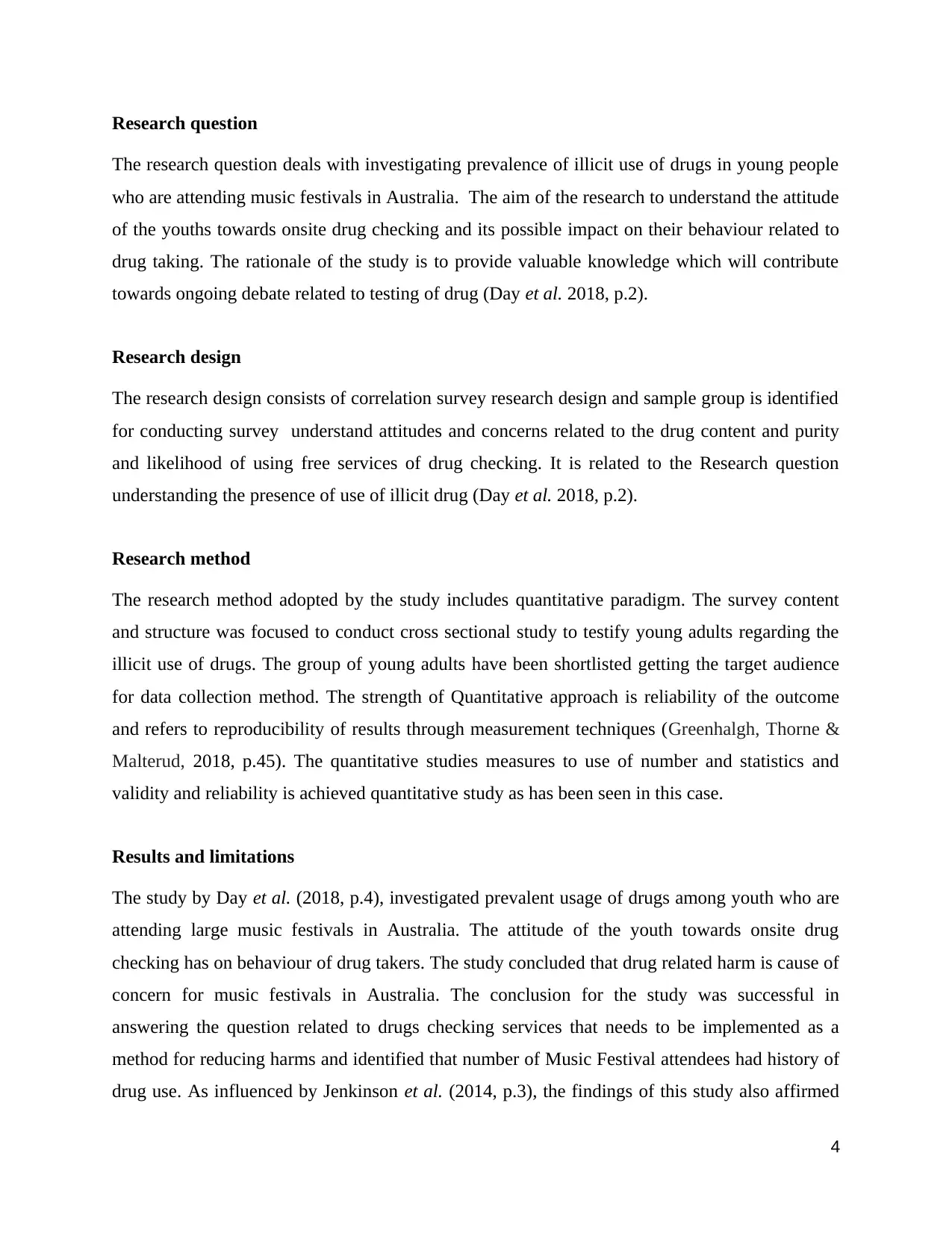
Research question
The research question deals with investigating prevalence of illicit use of drugs in young people
who are attending music festivals in Australia. The aim of the research to understand the attitude
of the youths towards onsite drug checking and its possible impact on their behaviour related to
drug taking. The rationale of the study is to provide valuable knowledge which will contribute
towards ongoing debate related to testing of drug (Day et al. 2018, p.2).
Research design
The research design consists of correlation survey research design and sample group is identified
for conducting survey understand attitudes and concerns related to the drug content and purity
and likelihood of using free services of drug checking. It is related to the Research question
understanding the presence of use of illicit drug (Day et al. 2018, p.2).
Research method
The research method adopted by the study includes quantitative paradigm. The survey content
and structure was focused to conduct cross sectional study to testify young adults regarding the
illicit use of drugs. The group of young adults have been shortlisted getting the target audience
for data collection method. The strength of Quantitative approach is reliability of the outcome
and refers to reproducibility of results through measurement techniques (Greenhalgh, Thorne &
Malterud, 2018, p.45). The quantitative studies measures to use of number and statistics and
validity and reliability is achieved quantitative study as has been seen in this case.
Results and limitations
The study by Day et al. (2018, p.4), investigated prevalent usage of drugs among youth who are
attending large music festivals in Australia. The attitude of the youth towards onsite drug
checking has on behaviour of drug takers. The study concluded that drug related harm is cause of
concern for music festivals in Australia. The conclusion for the study was successful in
answering the question related to drugs checking services that needs to be implemented as a
method for reducing harms and identified that number of Music Festival attendees had history of
drug use. As influenced by Jenkinson et al. (2014, p.3), the findings of this study also affirmed
4
The research question deals with investigating prevalence of illicit use of drugs in young people
who are attending music festivals in Australia. The aim of the research to understand the attitude
of the youths towards onsite drug checking and its possible impact on their behaviour related to
drug taking. The rationale of the study is to provide valuable knowledge which will contribute
towards ongoing debate related to testing of drug (Day et al. 2018, p.2).
Research design
The research design consists of correlation survey research design and sample group is identified
for conducting survey understand attitudes and concerns related to the drug content and purity
and likelihood of using free services of drug checking. It is related to the Research question
understanding the presence of use of illicit drug (Day et al. 2018, p.2).
Research method
The research method adopted by the study includes quantitative paradigm. The survey content
and structure was focused to conduct cross sectional study to testify young adults regarding the
illicit use of drugs. The group of young adults have been shortlisted getting the target audience
for data collection method. The strength of Quantitative approach is reliability of the outcome
and refers to reproducibility of results through measurement techniques (Greenhalgh, Thorne &
Malterud, 2018, p.45). The quantitative studies measures to use of number and statistics and
validity and reliability is achieved quantitative study as has been seen in this case.
Results and limitations
The study by Day et al. (2018, p.4), investigated prevalent usage of drugs among youth who are
attending large music festivals in Australia. The attitude of the youth towards onsite drug
checking has on behaviour of drug takers. The study concluded that drug related harm is cause of
concern for music festivals in Australia. The conclusion for the study was successful in
answering the question related to drugs checking services that needs to be implemented as a
method for reducing harms and identified that number of Music Festival attendees had history of
drug use. As influenced by Jenkinson et al. (2014, p.3), the findings of this study also affirmed
4
Paraphrase This Document
Need a fresh take? Get an instant paraphrase of this document with our AI Paraphraser
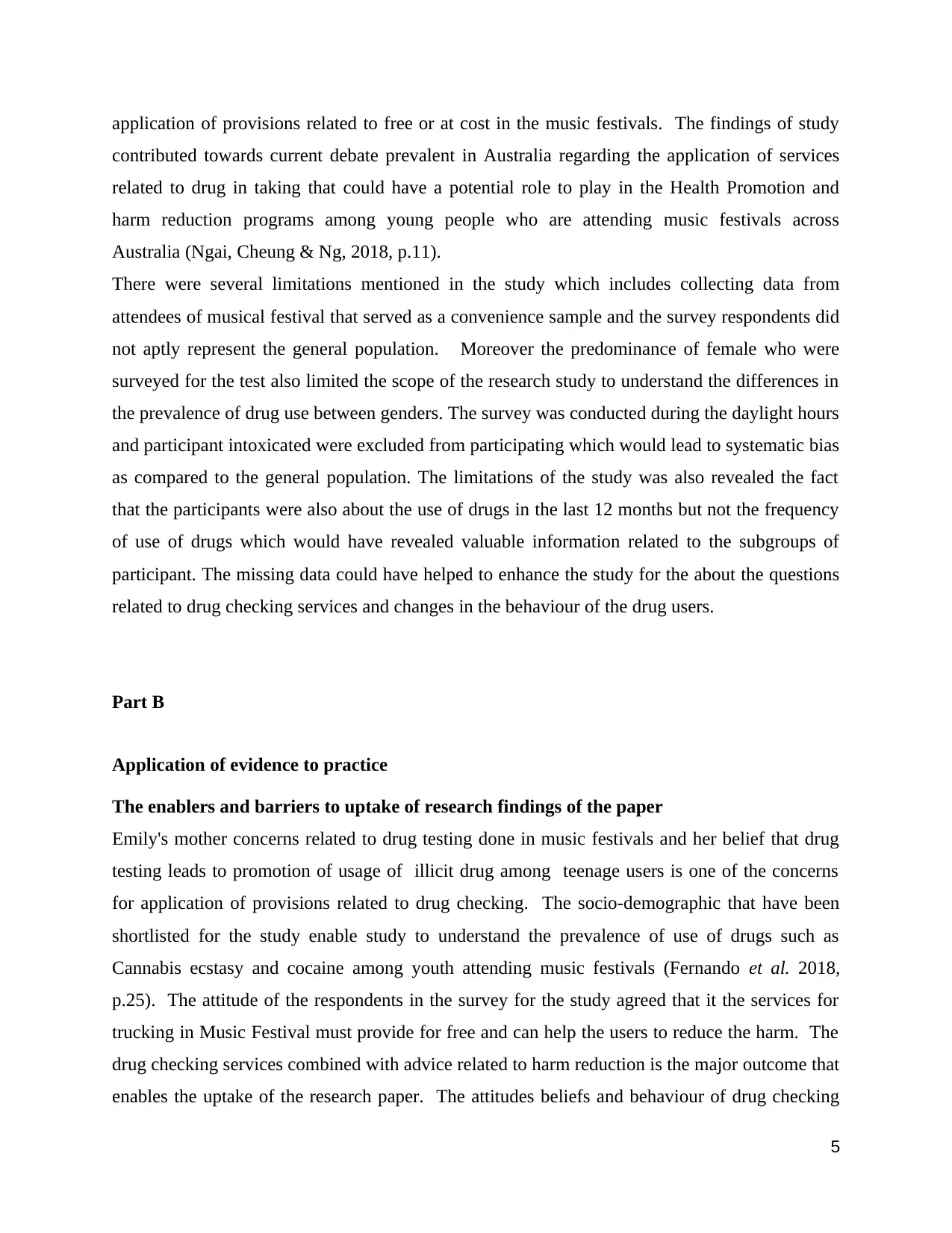
application of provisions related to free or at cost in the music festivals. The findings of study
contributed towards current debate prevalent in Australia regarding the application of services
related to drug in taking that could have a potential role to play in the Health Promotion and
harm reduction programs among young people who are attending music festivals across
Australia (Ngai, Cheung & Ng, 2018, p.11).
There were several limitations mentioned in the study which includes collecting data from
attendees of musical festival that served as a convenience sample and the survey respondents did
not aptly represent the general population. Moreover the predominance of female who were
surveyed for the test also limited the scope of the research study to understand the differences in
the prevalence of drug use between genders. The survey was conducted during the daylight hours
and participant intoxicated were excluded from participating which would lead to systematic bias
as compared to the general population. The limitations of the study was also revealed the fact
that the participants were also about the use of drugs in the last 12 months but not the frequency
of use of drugs which would have revealed valuable information related to the subgroups of
participant. The missing data could have helped to enhance the study for the about the questions
related to drug checking services and changes in the behaviour of the drug users.
Part B
Application of evidence to practice
The enablers and barriers to uptake of research findings of the paper
Emily's mother concerns related to drug testing done in music festivals and her belief that drug
testing leads to promotion of usage of illicit drug among teenage users is one of the concerns
for application of provisions related to drug checking. The socio-demographic that have been
shortlisted for the study enable study to understand the prevalence of use of drugs such as
Cannabis ecstasy and cocaine among youth attending music festivals (Fernando et al. 2018,
p.25). The attitude of the respondents in the survey for the study agreed that it the services for
trucking in Music Festival must provide for free and can help the users to reduce the harm. The
drug checking services combined with advice related to harm reduction is the major outcome that
enables the uptake of the research paper. The attitudes beliefs and behaviour of drug checking
5
contributed towards current debate prevalent in Australia regarding the application of services
related to drug in taking that could have a potential role to play in the Health Promotion and
harm reduction programs among young people who are attending music festivals across
Australia (Ngai, Cheung & Ng, 2018, p.11).
There were several limitations mentioned in the study which includes collecting data from
attendees of musical festival that served as a convenience sample and the survey respondents did
not aptly represent the general population. Moreover the predominance of female who were
surveyed for the test also limited the scope of the research study to understand the differences in
the prevalence of drug use between genders. The survey was conducted during the daylight hours
and participant intoxicated were excluded from participating which would lead to systematic bias
as compared to the general population. The limitations of the study was also revealed the fact
that the participants were also about the use of drugs in the last 12 months but not the frequency
of use of drugs which would have revealed valuable information related to the subgroups of
participant. The missing data could have helped to enhance the study for the about the questions
related to drug checking services and changes in the behaviour of the drug users.
Part B
Application of evidence to practice
The enablers and barriers to uptake of research findings of the paper
Emily's mother concerns related to drug testing done in music festivals and her belief that drug
testing leads to promotion of usage of illicit drug among teenage users is one of the concerns
for application of provisions related to drug checking. The socio-demographic that have been
shortlisted for the study enable study to understand the prevalence of use of drugs such as
Cannabis ecstasy and cocaine among youth attending music festivals (Fernando et al. 2018,
p.25). The attitude of the respondents in the survey for the study agreed that it the services for
trucking in Music Festival must provide for free and can help the users to reduce the harm. The
drug checking services combined with advice related to harm reduction is the major outcome that
enables the uptake of the research paper. The attitudes beliefs and behaviour of drug checking
5
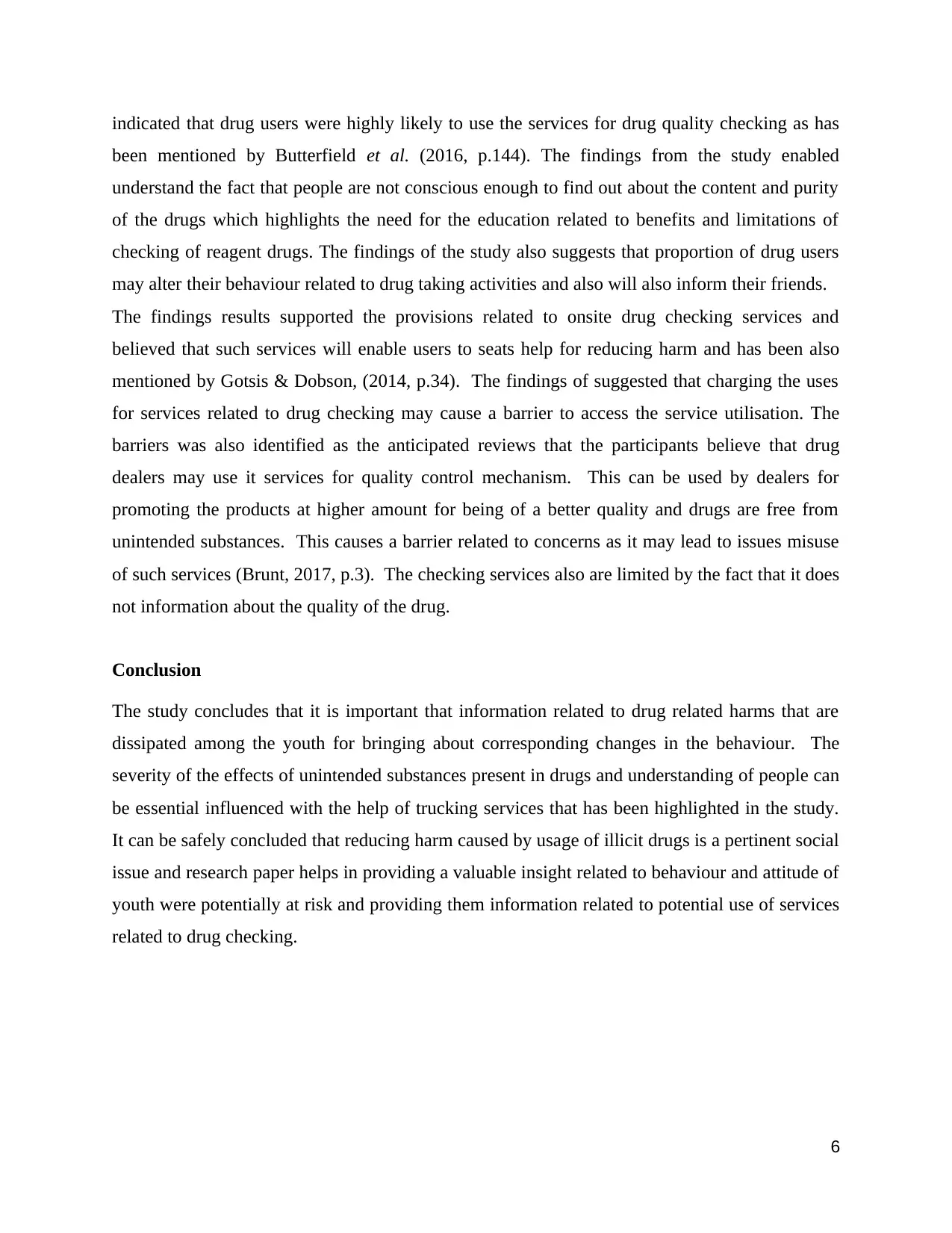
indicated that drug users were highly likely to use the services for drug quality checking as has
been mentioned by Butterfield et al. (2016, p.144). The findings from the study enabled
understand the fact that people are not conscious enough to find out about the content and purity
of the drugs which highlights the need for the education related to benefits and limitations of
checking of reagent drugs. The findings of the study also suggests that proportion of drug users
may alter their behaviour related to drug taking activities and also will also inform their friends.
The findings results supported the provisions related to onsite drug checking services and
believed that such services will enable users to seats help for reducing harm and has been also
mentioned by Gotsis & Dobson, (2014, p.34). The findings of suggested that charging the uses
for services related to drug checking may cause a barrier to access the service utilisation. The
barriers was also identified as the anticipated reviews that the participants believe that drug
dealers may use it services for quality control mechanism. This can be used by dealers for
promoting the products at higher amount for being of a better quality and drugs are free from
unintended substances. This causes a barrier related to concerns as it may lead to issues misuse
of such services (Brunt, 2017, p.3). The checking services also are limited by the fact that it does
not information about the quality of the drug.
Conclusion
The study concludes that it is important that information related to drug related harms that are
dissipated among the youth for bringing about corresponding changes in the behaviour. The
severity of the effects of unintended substances present in drugs and understanding of people can
be essential influenced with the help of trucking services that has been highlighted in the study.
It can be safely concluded that reducing harm caused by usage of illicit drugs is a pertinent social
issue and research paper helps in providing a valuable insight related to behaviour and attitude of
youth were potentially at risk and providing them information related to potential use of services
related to drug checking.
6
been mentioned by Butterfield et al. (2016, p.144). The findings from the study enabled
understand the fact that people are not conscious enough to find out about the content and purity
of the drugs which highlights the need for the education related to benefits and limitations of
checking of reagent drugs. The findings of the study also suggests that proportion of drug users
may alter their behaviour related to drug taking activities and also will also inform their friends.
The findings results supported the provisions related to onsite drug checking services and
believed that such services will enable users to seats help for reducing harm and has been also
mentioned by Gotsis & Dobson, (2014, p.34). The findings of suggested that charging the uses
for services related to drug checking may cause a barrier to access the service utilisation. The
barriers was also identified as the anticipated reviews that the participants believe that drug
dealers may use it services for quality control mechanism. This can be used by dealers for
promoting the products at higher amount for being of a better quality and drugs are free from
unintended substances. This causes a barrier related to concerns as it may lead to issues misuse
of such services (Brunt, 2017, p.3). The checking services also are limited by the fact that it does
not information about the quality of the drug.
Conclusion
The study concludes that it is important that information related to drug related harms that are
dissipated among the youth for bringing about corresponding changes in the behaviour. The
severity of the effects of unintended substances present in drugs and understanding of people can
be essential influenced with the help of trucking services that has been highlighted in the study.
It can be safely concluded that reducing harm caused by usage of illicit drugs is a pertinent social
issue and research paper helps in providing a valuable insight related to behaviour and attitude of
youth were potentially at risk and providing them information related to potential use of services
related to drug checking.
6
⊘ This is a preview!⊘
Do you want full access?
Subscribe today to unlock all pages.

Trusted by 1+ million students worldwide
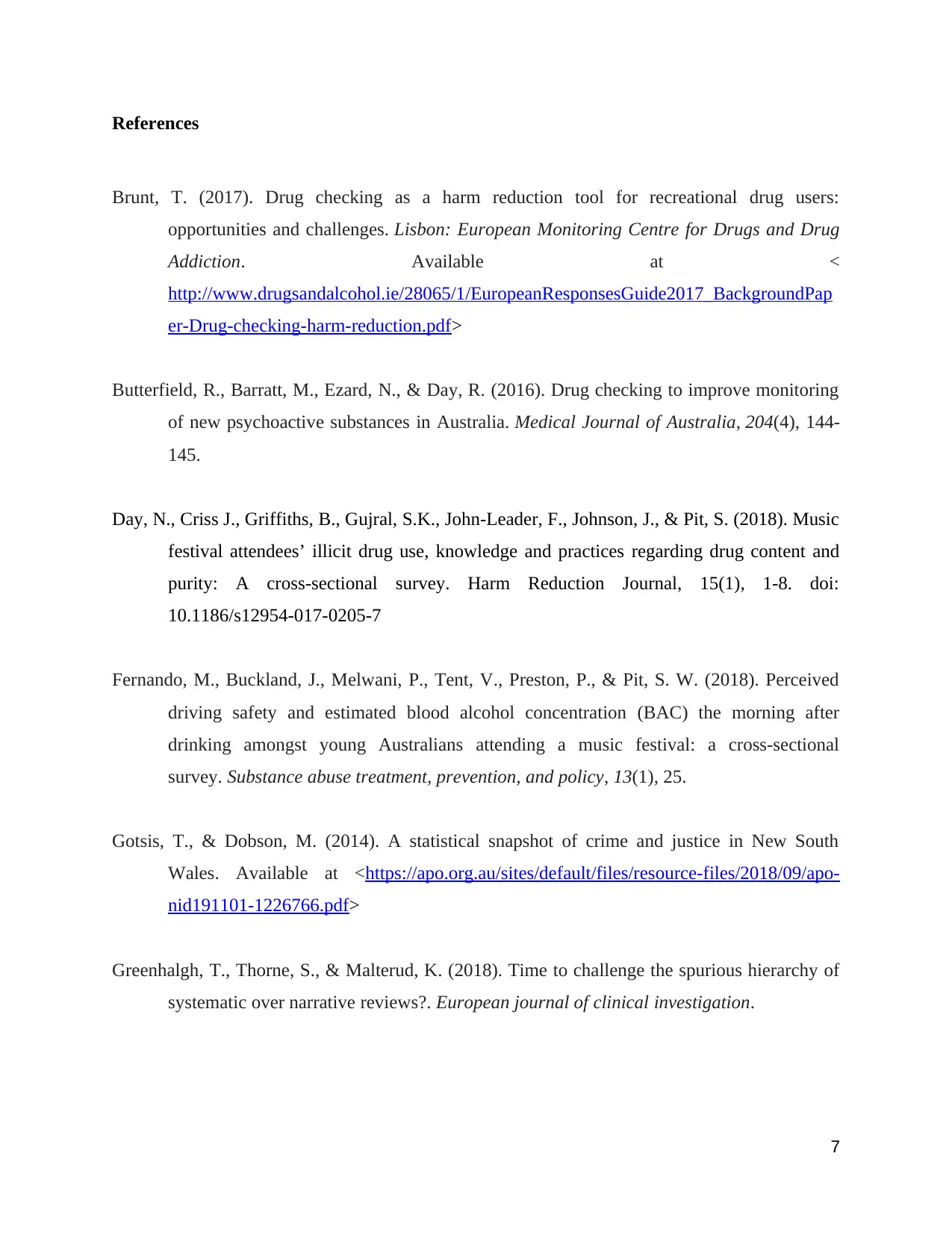
References
Brunt, T. (2017). Drug checking as a harm reduction tool for recreational drug users:
opportunities and challenges. Lisbon: European Monitoring Centre for Drugs and Drug
Addiction. Available at <
http://www.drugsandalcohol.ie/28065/1/EuropeanResponsesGuide2017_BackgroundPap
er-Drug-checking-harm-reduction.pdf>
Butterfield, R., Barratt, M., Ezard, N., & Day, R. (2016). Drug checking to improve monitoring
of new psychoactive substances in Australia. Medical Journal of Australia, 204(4), 144-
145.
Day, N., Criss J., Griffiths, B., Gujral, S.K., John-Leader, F., Johnson, J., & Pit, S. (2018). Music
festival attendees’ illicit drug use, knowledge and practices regarding drug content and
purity: A cross-sectional survey. Harm Reduction Journal, 15(1), 1-8. doi:
10.1186/s12954-017-0205-7
Fernando, M., Buckland, J., Melwani, P., Tent, V., Preston, P., & Pit, S. W. (2018). Perceived
driving safety and estimated blood alcohol concentration (BAC) the morning after
drinking amongst young Australians attending a music festival: a cross-sectional
survey. Substance abuse treatment, prevention, and policy, 13(1), 25.
Gotsis, T., & Dobson, M. (2014). A statistical snapshot of crime and justice in New South
Wales. Available at <https://apo.org.au/sites/default/files/resource-files/2018/09/apo-
nid191101-1226766.pdf>
Greenhalgh, T., Thorne, S., & Malterud, K. (2018). Time to challenge the spurious hierarchy of
systematic over narrative reviews?. European journal of clinical investigation.
7
Brunt, T. (2017). Drug checking as a harm reduction tool for recreational drug users:
opportunities and challenges. Lisbon: European Monitoring Centre for Drugs and Drug
Addiction. Available at <
http://www.drugsandalcohol.ie/28065/1/EuropeanResponsesGuide2017_BackgroundPap
er-Drug-checking-harm-reduction.pdf>
Butterfield, R., Barratt, M., Ezard, N., & Day, R. (2016). Drug checking to improve monitoring
of new psychoactive substances in Australia. Medical Journal of Australia, 204(4), 144-
145.
Day, N., Criss J., Griffiths, B., Gujral, S.K., John-Leader, F., Johnson, J., & Pit, S. (2018). Music
festival attendees’ illicit drug use, knowledge and practices regarding drug content and
purity: A cross-sectional survey. Harm Reduction Journal, 15(1), 1-8. doi:
10.1186/s12954-017-0205-7
Fernando, M., Buckland, J., Melwani, P., Tent, V., Preston, P., & Pit, S. W. (2018). Perceived
driving safety and estimated blood alcohol concentration (BAC) the morning after
drinking amongst young Australians attending a music festival: a cross-sectional
survey. Substance abuse treatment, prevention, and policy, 13(1), 25.
Gotsis, T., & Dobson, M. (2014). A statistical snapshot of crime and justice in New South
Wales. Available at <https://apo.org.au/sites/default/files/resource-files/2018/09/apo-
nid191101-1226766.pdf>
Greenhalgh, T., Thorne, S., & Malterud, K. (2018). Time to challenge the spurious hierarchy of
systematic over narrative reviews?. European journal of clinical investigation.
7
Paraphrase This Document
Need a fresh take? Get an instant paraphrase of this document with our AI Paraphraser
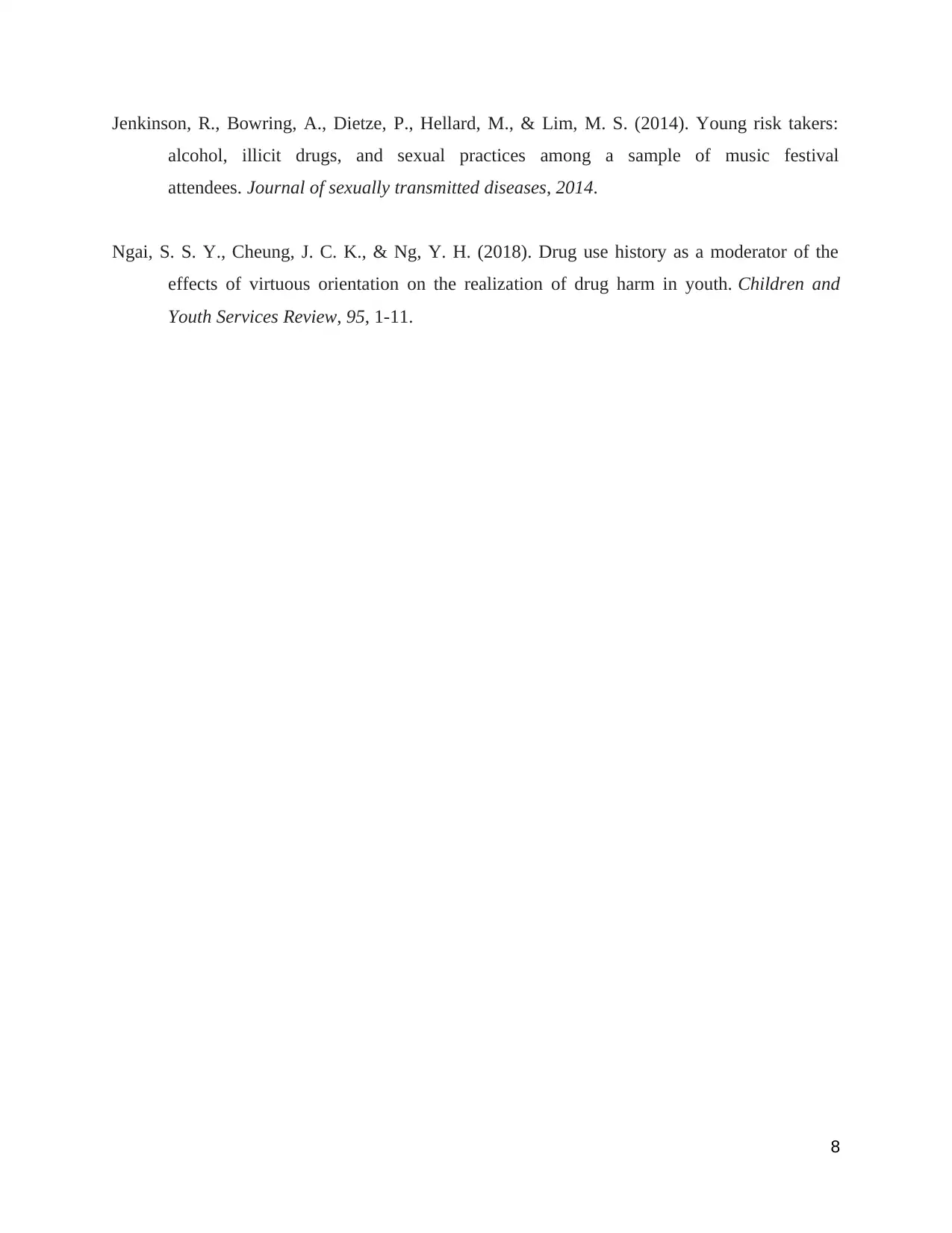
Jenkinson, R., Bowring, A., Dietze, P., Hellard, M., & Lim, M. S. (2014). Young risk takers:
alcohol, illicit drugs, and sexual practices among a sample of music festival
attendees. Journal of sexually transmitted diseases, 2014.
Ngai, S. S. Y., Cheung, J. C. K., & Ng, Y. H. (2018). Drug use history as a moderator of the
effects of virtuous orientation on the realization of drug harm in youth. Children and
Youth Services Review, 95, 1-11.
8
alcohol, illicit drugs, and sexual practices among a sample of music festival
attendees. Journal of sexually transmitted diseases, 2014.
Ngai, S. S. Y., Cheung, J. C. K., & Ng, Y. H. (2018). Drug use history as a moderator of the
effects of virtuous orientation on the realization of drug harm in youth. Children and
Youth Services Review, 95, 1-11.
8
1 out of 8
Related Documents
Your All-in-One AI-Powered Toolkit for Academic Success.
+13062052269
info@desklib.com
Available 24*7 on WhatsApp / Email
![[object Object]](/_next/static/media/star-bottom.7253800d.svg)
Unlock your academic potential
Copyright © 2020–2025 A2Z Services. All Rights Reserved. Developed and managed by ZUCOL.




